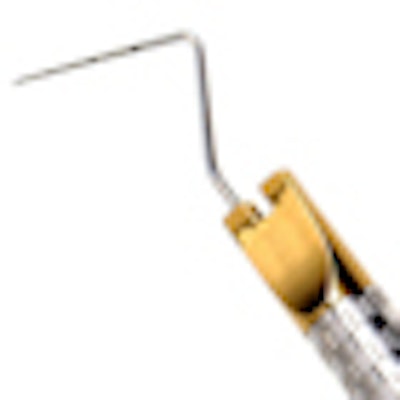
A U.K. company has designed a periodontal tool that it claims can alleviate the difficulty of achieving consistent measurements during periodontal tissue probing.
Implantium has partnered with Iain Chapple, BDS, head of periodontology at the University of Birmingham, to design and develop this double-ended, force-measuring probe.
“We believe the final product will be of genuine interest to the industry.”
— Jason Buglass, director, Implantium
Inconsistent probing pressure is a major source of measurement variation and discomfort for patients. But the UB-WHO-CF15 probe creates a standardization of probing pressure that improves the consistency and quality of periodontal measurement and also reduces patient discomfort, according to the company.
The probe combines a World Health Organization (WHO) C-type end for screening periodontal disease with a 15-mm, graduated end to enable detailed measures of probing pocket depth, recession, and attachment levels. Its design also enables effective washer disinfection and autoclaving.
The probe was developed in response to discussions the company held with Dr. Chapple, who suggested combining the two tips into a single instrument.
"This was technically quite difficult to do," said Jason Buglass, director of Implantium.
Dr. Chapple also tested and evaluated its effectiveness, consistency, and ability to be safely decontaminated.
Ergonomic advantages
The probe was developed over a period of nine months and manufactured in Korea. It has a hollow cylinder handle and is ergonomically shaped with two force-measuring tips. One of these is the standard WHO measurement with a ball of less than 1 mm, while the other is a 15-mm UNC (University of North Carolina) measurement, graduated in 1-mm increments to 15 mm.
 The UB-WHO-CF15 periodontal probe, developed by Implantium.
The UB-WHO-CF15 periodontal probe, developed by Implantium.
The force measurement is achieved by deflecting the tip on a spring basis so that it lines up between two prongs. When it is lined up in the center of the two prongs, it exerts a force of 0.2 N (20-g load).
"The instrument is very consistent at this measurement," Buglass explained. "This means that the same force can be used by different operators on different days to give a consistent measuring force, thus providing the ability to compare results."
In other words, it calibrates the measurement process, which is very important in periodontal treatment as consistent measurements can give an indication of disease progression, he noted.
"It is a real challenge to achieve consistent measurements with perio probes," Buglass explained.
The probe is a major step forward from previous instruments because by producing consistent measurement forces, more relevant comparisons can be made over time, he added. The main benefits are its ergonomic design, ability to decontaminate, and consistent force measurements, according to Buglass.
"The design is ergonomic to reduce the risk of repetitive strain, and the calibrated forces make it more comfortable for the patient," he said.
The instrument costs 85 pounds ($136 U.S.), and the company can supply it from the U.K. but is also seeking a dealer in the U.S. It has not been clinically tested, but the company is considering that now. It does have a CE Mark.
"We believe the final product will be of genuine interest to the industry, and at a cost of just 85 pounds plus VAT [value added tax], is an extremely cost-effective solution, too," Buglass said.
"I generally think that this is a major advancement in perio," said Thomas Dietrich, DMD, head of oral surgery at the University of Birmingham. "It's a simple but great idea, and it will vastly improve measurement quality."



















